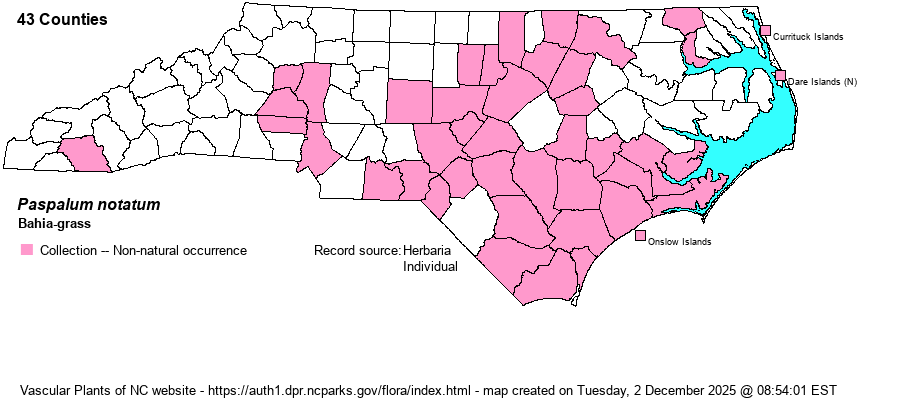| Author | Fluegge | |
| Distribution | Coastal Plain, Sandhills, and Piedmont; disjunct to Macon County in the Mountains. Certain to increase its distribution, as it is often used in roadside seed mixes, for erosion control, and as a turf grass.
Native of the New World, from Mex. to northern Argentina; in N.A. from NC and TN to FL and TX. | |
| Abundance | Frequent and becoming common throughout Coastal Plain and Piedmont; apparently rare in the Mountains. | |
| Habitat | Roadsides, lawn weed, campuses, pastures, disturbed soils. In recent decades it has spread on roadsides and eliminated many more interesting plants, natives and aliens alike. Some roadsides have thus become monocultures. |
| Phenology | Flowering and fruiting June-October. | |
| Identification | Bahia Grass grows from a tough horizontal rhizome. Culms are erect and usually 1-2 feet tall, topped by 2 inflorescence branches (sometimes 1-3 additional branches below). When flowering, the dark brown anthers stand out. | |
| Taxonomic Comments | Paspalum is a genus of more than 300 species, found mostly in the New World. The genus is quite easily identified by the neat row of spikelets along each side of a flattened rachis (inflorescence branch), and also by the hemispherical outline of each spikelet. In some species there are only 2 such inflorescence branches, paired at the stem summit; in most of our species there are 3-4 branches; and in a few there may be many. Keys ask whether spikelets are paired or not -- that is, at each node on each side of the rachis there are pairs of spikelets on tiny stalklets. Care must be taken with a hand lens to make sure there are 2 stalklets at each node, as frequently one of the two spikelets will not grow. Non-paired or single spikelets will clearly have only a single stalklet per node. | |
| Other Common Name(s) | | |
| State Rank | SE * | |
| Global Rank | GNR | |
| State Status | | |
| US Status | | |
| USACE-agcp | FACU link |
| USACE-emp | FACU link |

